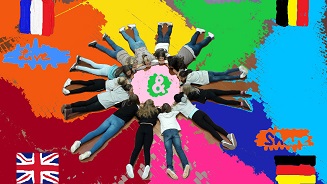'Restore' good practices in St.-Paulus Kortrijk
In May 2012 Mister Michael Michiels, old student of our school St.-Paulus Kortrijk, present his project ‘Restorative Practice in education’. A systematic recovery-oriented approach also contributes to a more respectful and more emancipatory school climate. This has a positive impact on the well-being and learning process of each person.
The non-profit organization Recovery-oriented Working at School guarantees a solid combination of expertise and know-how. It consists of organizations from the welfare sector, care, education and academics. Together they set up a three-year project that aims to make St.-Paulus an example of the restorative philosophy.
The first year is was mainly about inspiration. We start from a baseline: where is our school today, what needs do we have with the school team, the pupils and their parents? We look at the need for training, starting with a core team and also take the first steps of the learning process. In the second year, the implementation of restorative work is central throughout the school. This means that not only teachers, but also pupils and support staff are actively involved. The last year focuses on the roll-out phase: keeping the process going through intervision groups, exchanging the experience gained with other schools and the neighborhood.
As team we learned more about the theoretical framework of restorative practices, different restorative techniques, alternatives for punishment, to reflect on a restorative attitude, to see conflict as an opportunity to grow, facilitate proactive circles, use restorative questions.
We implement the idea of restore by using the animals of the Axen rose worked out by Ferdinand Cuvelier to improve interaction with others. We want to learn our children to express there feelings and communication with better vocabulary to speak about social skills. This common language makes it easier to discuss situations. Pupils even very young pupils, can at a given moment determine for themselves which animal they are good at and which they want to use, but can’t (properly) use. They also get a better picture of the social behavior of others and they learn to name it. Very quickly we noticed that students do not always find it easy to express their feelings in a correct way. Their vocabulary was too limited to clearly tell what they feel. Being able to name feelings helps prevent bullying.
With students of Vives high school we worked out a program to combine, translate and implement the restore idea with the animals of the axen rose. Children are trained to come ambassadors and mediators of restore, we called them also ‘Sweeties’, in a 2 hours during workshop with 4 sessions. The intention is that these Sweeties are the contact point on the playground and help other children. They mediate in quarrels, involve all children in the game, teach younger children various games, can point to dangerous play and they are trust children. Because of their recognisability on the playground by wearing a hi vi vest they can invoke as playing along or playing honestly do not automatically succeed.
We developed new visible restorative – oriented ideas in the school e.g. a visual bord, restore cards, mailbox with an owl (hold on, the wise one) and animation video with explanation of the purpose, …
Johan Vanhouwaert is coordinating the steering group. He works both proactively and curatively. He demonstrated, for example, how a proactive circle can run in the classroom. If something going wrong and the case is too complex to be solved by the teacher himself, then Johan starts a treatment plan. In some exceptional cases parents, teachers, ... can be involved. Possible action plans may consist of individual recovery interviews, two-way interviews, group discussions and, exceptionally, a restorative group discussion in which all actors (and that may also be parents) are present. They are very exceptional. Each case is fed back to the teacher involved and sometimes also discussed in a team.
During formal and informal discussions, parents express their enthusiasm about the warm way of our approach. Real bullying does not get a chance. With signals, a recovery-oriented approach is immediately taken.
However, some parents find restorative practices too soft. They sometimes demand a punishment. Certainly parents sometimes have the impression that 'the perpetrator' ends up with a cheap conversation. After a conflict we always try to consult first to repair the damage and the relationship. We will discuss how hard that follow-up weighs with the pupil. Is making a drawing for the teacher or giving a hug enough? Or should it be more? We only do penalties if the consultations do not work out or if there is no desire for recovery from one of the parties. It is very important to communicate very well with the parents about this system. Some teachers sometimes have difficulties with this approach and still need to grow in the restorative vision. They want to immediately indicate a solution after a conflict instead of starting from the dialogue. That is why it is so important that cases are discussed at staff meetings. And especially how they were solved. The experience is that the children usually want to find a solution. But they sometimes have to come to calm down, first stand on the wall or just relax with another teacher. If the child has 'cooled down', it will be prepared to start the recovery interview. There are still little fights at the playground at school. Sometimes there is still a noise in the corridor. But much less than before. Today the children can tell their story and their feelings. We teach the pupils to put their feelings first and to express them. They no longer feel "they do not understand me". They become aggressive in conflicts less quickly. The children like to come to school and the teachers too. Of course, problems at school sometimes find their origin at home. We usually can’t do much about that, but as a school we want to be a home, a safe place for children in difficult situations.
